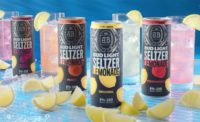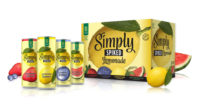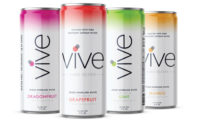Special Report
Market saturation prompts hard seltzers to differentiate through key attributes
Gen X, millennials top consumers for hard seltzers

SVEDKA Tropics Tea Spritz, a new spirits-based hard seltzer, is available in three flavors: Pineapple Guava, Raspberry Kiwi and Orange Mango
Image courtesy of Constellation Brands
Whether it is artists, professional athletes or musical artists, the historic figures who adapted as their career skills changed were able to celebrate elongated fanfare thanks to this flexibility. In the beverage market, hard seltzers were the star of new product development for a few years, but as the market has become more saturated, experts note that change might be in order as the beverage alcohol segment experiences deceleration from its years of growth.
“Beer seltzers, the biggest contributor to [the ready-to-drink] (RTD) category, has slowed from plus 42% for the three-year [compound annual growth rate] (CAGR) to plus 1% in [last 52 weeks] ending April 17, 2022,” say Ravee Krishnan and Ryan Toenies, client insights consultants for Chicago-based Information Resources Inc. (IRI). “Spirits seltzers, the second smallest contributor to RTD category, happens to be the second biggest contributor to RTD growth. As the segment doubled (plus 125%) in the latest 52 weeks, High Noon contributed to more than two-thirds of the growth. It will be interesting to watch this space. Will High Noon sustain this growth? Will other brands capitalize this segment’s growth?”
Liz Paquette, head of consumer insights at Drizly, Boston, notes that the company defines hard seltzer as a flavor malt beverage (FMB), categorizing it as a subcategory within beer. Meanwhile the spirit-based seltzer as defined by the eCommerce platform is that of ready-to-drink, making it a subcategory within liquor. Given this distinction, Paquette explains that within the Drizly platform, hard seltzers still remain a top performer within beer, but has started to slow.

Image courtesy of The Boston Beer Co.
“Over the past five years, hard seltzer has grown from a relatively unknown category to the best-selling beer subcategory on Drizly,” Paquette says. “Though the hard seltzer category as we know it today debuted in 2013 with Bon V!V, then known as Spiked Seltzer, it didn’t really take off until the summer of 2019 when it first surpassed light lager as Drizly’s best-selling beer subcategory on the Fourth of July. On Drizly, hard seltzer held 14% of beer category share that year, compared to just 5% in 2018.
“The rise continued as hard seltzer reached a 19% share of beer sales on Drizly in 2020 and a 21% share in 2021,” she continues. “Over those three years of growth, hard seltzer held a 2.6% share on Drizly overall in 2019, a 3.4% share in 2020, and a 3.3% share in 2021.”
Year-to-date, hard seltzers stand at a 3% share on Drizly overall and 21% share within beer, Paquette notes.
“That said, hard seltzer is experiencing competition from spirit-based, ready-to-drink (RTD) cocktails,” she explains. “Marking a significant shift, during the 2022 Memorial Day weekend, the percent share of the RTD subcategory first surpassed that of the hard seltzer subcategory on Drizly. RTDs held 4.8% share over Memorial Day weekend specifically, while hard seltzer held 4.4% share on Drizly.”
Year-to-date, RTDs account for a 5.1% share in liquor on Drizly. And based on consumer insights, spirit-based canned cocktails look to be ascending in popularity for Drizly consumers.
“In Drizly’s 2022 Consumer Trend Report, 22% of respondents cited ready-to-drink cocktails as the canned drink they anticipate buying more of in 2022 compared to 2021, two percentage points ahead of hard seltzer (20%) and 10 percentage points ahead of lager (11%),” Paquette says. “The fact that RTDs are outpacing hard seltzers among ‘most likely to buy more’ canned options underscores a leveling off for hard seltzer that Drizly was among the first to identify in 2021, when hard seltzers’ share of overall adult beverage sales declined for the first time on the platform.
“That decline, coupled with RTD cocktails’ concurrent meteoric rise, suggests that RTDs may be taking share from hard seltzers,” she continues. “Hard seltzer’s history over the past three years could be a blueprint for RTD’s near-term prospects. From 2018-2020, hard seltzer experienced a 278% growth in share (sitting at 3.4% share on Drizly in 2020) and from 2019-2021, RTDs experienced a 400% growth in share (sitting at 2% share overall on Drizly in 2021).”
IRI’s Krishnan and Toenies also highlight the growth of spirit-centric seltzers, but remain measured whether the segment will attain the presence that beer-centric seltzers have attained.
“Spirits seltzers segments has been more than doubling for the last three years yet remains less than one-tenth of beer seltzers and High Noon is the primary driver of this segment, at the moment,” they say. “The segment with the current players, doesn’t seem to be on a track to match levels of beer seltzers. There are several high-profile launches anticipated in this segment in the next few months. It remains to be seen if they are able to do what White Claw and Truly have done to the RTD category.”
|
|
DOLLAR SALES | % CHANGE vs PRIOR YEAR | CASE SALES | % CHANGE vs PRIOR YEAR | |
| 1 | High Noon | $170,955,791 | 136.5 | 3,124,148 | 140.3 |
| 2 | Absolut | $11,048,004 | 77.8 | 169,233 | 66.6 |
| 3 | Monaco | $9,423,000 | 3.8 | 144,492 | 2.1 |
| 4 | Ketel One | $7,785,556 | 101 | 99,681 | 101.1 |
| 5 | Cutwater Spirits | $7,089,655 | 32.6 | 132,610 | 40.1 |
|
|
Category Total* | $250,308,413 | 117.9 | 4,264,210 | 120.2 |
*Includes brands not listed
Source: Information Resources, Inc. (IRI), Chicago. Total U.S. supermarkets, drug stores, gas and convenience stores, mass merchandisers, military commissaries, and select club and dollar retail chains for the 52 weeks ending Jun 12.
Makings for success
As more beer-centric and spirit-centric seltzers enter the market, research shows that it’s a specific sect of consumers that have been driving the categories.
“Gen X and millennials contribute to three-fourth of the volume of beer and spirits seltzers,” Krishnan and Toenies say. “For reference, these groups contribute to less than half the volume for total liquor. These two groups have been driving this segment with the flavor forward and format preference.”
Within the Drizly platform, millennials remain the dominate consumer of hard seltzers, Paquette notes.
“Though hard seltzer has broad appeal, on Drizly, sales continue to be dominated by millennials, who hold 63% of share (versus 53% of overall share on Drizly),” she explains. “Gen Z also over-indexes on hard seltzer, holding 9% of share (versus 4% overall).”
Beyond demographics, though, experts note that the driving force of beer-centric and spirit-centric seltzers are their ability to tap into wellness-associated aspects.
“[The] RTD category appears to satisfy an immediate consumption need with attributes like low calorie, low ABV, and other ‘better-for-you’ attributes which are slightly sweet in flavor,” IRI’s Krishnan and Toenies say. “Consumers appear to show these products as more an all-encompassing category rather than just RTD or FMB or seltzers.”
Drizly’s Paquette notes that new innovations within hard seltzers (as they define them) are mirroring the macro consumer wellness trends.
“Brands that offer SKUs that are lighter in ABV and calories are gaining traction on Drizly,” she says. “For instance, popular ranch water brands like Lone River have experienced growth over the past few years - with Lone River scaling 700% of share from 2020 to 2022 to date. Fan-favorite Topo Chico has also seen significant gains. Having launched their first hard seltzer in 2021, Topo Chico quickly broke into the Top 5 hard seltzer brands on Drizly and currently holds the No. 3 spot in 2022 to date (following White Claw and Truly Hard Seltzer).”

Image courtesy of White Claw/Mike’s Hard Lemonade Co.
However, for the RTD spirit seltzers, Drizly is seeing the greater influence of trends from the spirits market influence the innovation.
“We are seeing trends in the spirits space carry over to hard seltzer and RTDs ― particularly when it comes to tequila,” Paquette says. “Tequila has been the fastest-growing spirits category in terms of share gains on Drizly over the past few years. Tequila holds 18% share of the liquor category on Drizly in the past year. It’s the latest in a steady rise that’s seen tequila share go from 10% in 2017, to 13% in 2019, and 15% in 2020.
“There is a thirst for tequila in the hard seltzer and RTD formats,” she continues. “In Drizly’s 2022
Consumer Trend Report 43% of respondents cited tequila-based RTDs as the emerging category they are most interested in. That outpaced other rising options like hard iced tea (35%) and hard kombucha (13%).”
Eyes on the competition
Given the market potential for beer-centric and spirits-centric hard seltzers, the categories have seen an influx of brands. As these new innovators enter a more saturated marketplace, experts note that the successful entrants have targeted more niche need states.
“Some products are looking to differentiate themselves with ‘better-for-you’ claims like organic, low calories, zero sugar, natural flavors, etc., e.g., Michelob Ultra organic seltzer (zero sugar, 80 calories, zero carbs),” IRI’s Krishnan and Toenies note.
|
|
DOLLAR SALES | % CHANGE vs PRIOR YEAR | CASE SALES | % CHANGE vs PRIOR YEAR | |
| 1 | White Claw Hard Seltzer | $1,909,849,373 | -5.5 | 52,202,822 | -8.9 |
| 2 | Truly | $1,191,088,897 | 3.2 | 34,597,494 | -1.7 |
| 3 | Bud Light Seltzer | $392,284,338 | -9.1 | 12,163,891 | -13.4 |
| 4 | Topo Chico Hard Seltzer | $149,427,512 | 509 | 4,323,239 | 487 |
| 5 | Vizzy | $140,143,011 | 21.9 | 4,273,174 | 18.9 |
|
|
Category Total* | $4,409,193,341 | -0.5 | 125,668,803 | -4.6 |
*Includes brands not listed
Source: Information Resources, Inc. (IRI), Chicago. Total U.S. supermarkets, drug stores, gas and convenience stores, mass merchandisers, military commissaries, and select club and dollar retail chains for the 52 weeks ending Jun 12.
The client insights consultants add that some brands, for example, Corona hard seltzer, Michelob Ultra hard seltzer, Smirnoff seltzer, have been benefited from their brand equity when they entered the space.
Echoing her statements earlier that until 2019, a few big hard seltzer brands dominated sales, Drizly’s Paquette says. Today, White Claw remains the dominate brand on the Drizly platform, but is seeing competition from beer associated brands, i.e., Bud Light, Corona and even craft brewers.
“As mentioned above, brands leaning into SKUs that are lighter in ABV and calories are gaining traction on Drizly,” she says. “Variety packs are also top sellers for hard seltzer on Drizly. Eighty percent share of hard seltzer sales on Drizly are 12-packs, compared to 32% share in core beer sales.”
Yet, for the RTD segment, Paquette notes that the proliferation of variety has fueled the category and perhaps even influenced the launch of more RTD products.
“As of June 2022, the number of RTD brands on Drizly has increased 157% since June 2019,” Paquette says. “Despite the plethora of offerings, however, one brand — High Noon— continues to dominate the category. The brand has held the No. 1 position on Drizly’s list of top-selling RTD brands since 2020.
“Despite the dominance of High Noon, Cutwater made serious gains within the RTD category over the past year, with its best-selling Cutwater Tequila Margarita rising to No. 3 on Drizly’s top-selling SKUs list in 2022,” she continues. “This underscores trends within the category that resonate with consumers; other than light, fresh, hard seltzer-like RTDs, Margarita RTDs lead offerings, with Cutwater, Skinnygirl, and On The Rocks in leading positions.”
Whether its beer-centric or spirits-centric hard seltzers, it seems as though there’s no shortage of innovation or opportunity to reach today’s beverage alcohol consumers.
Looking for a reprint of this article?
From high-res PDFs to custom plaques, order your copy today!







